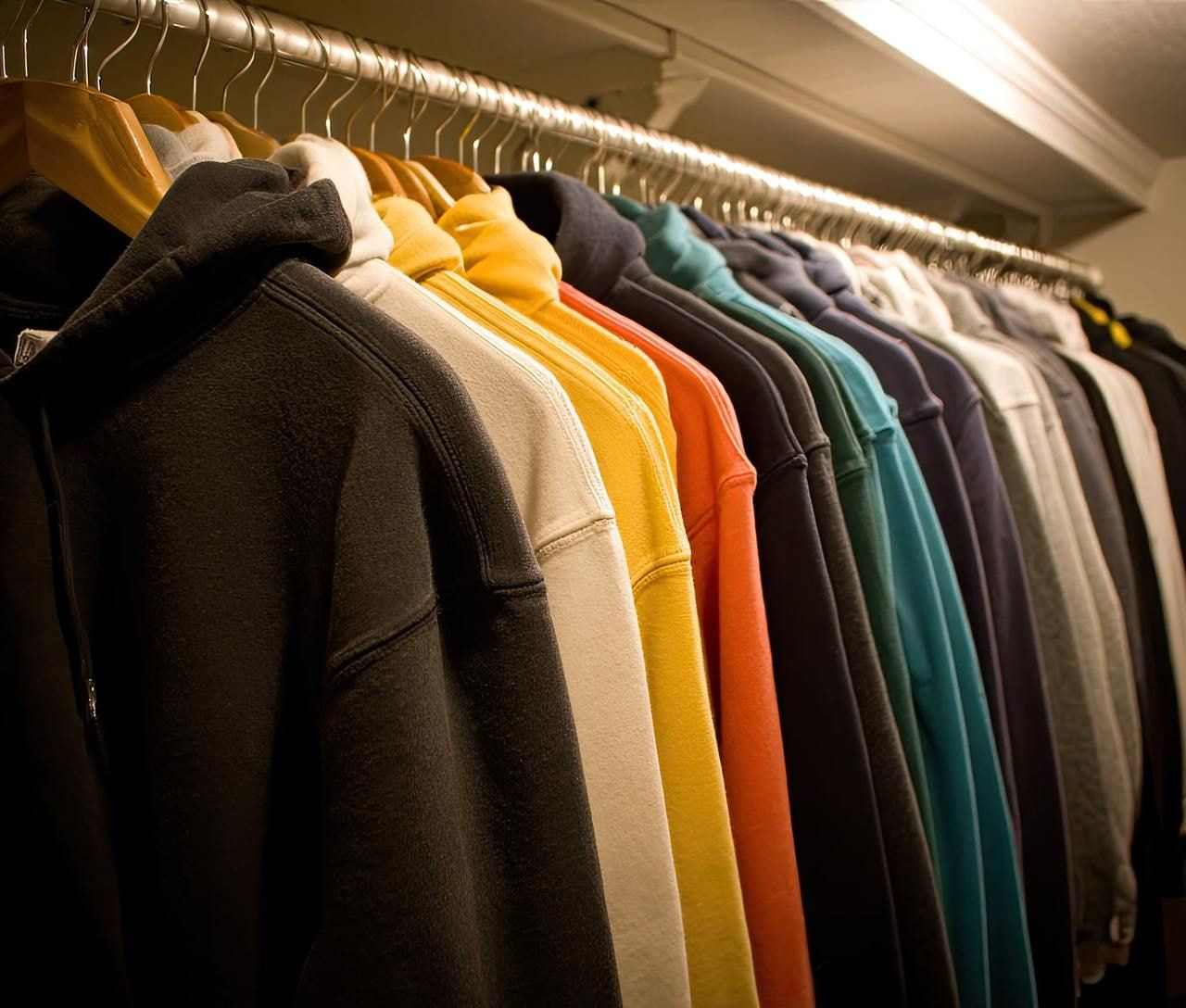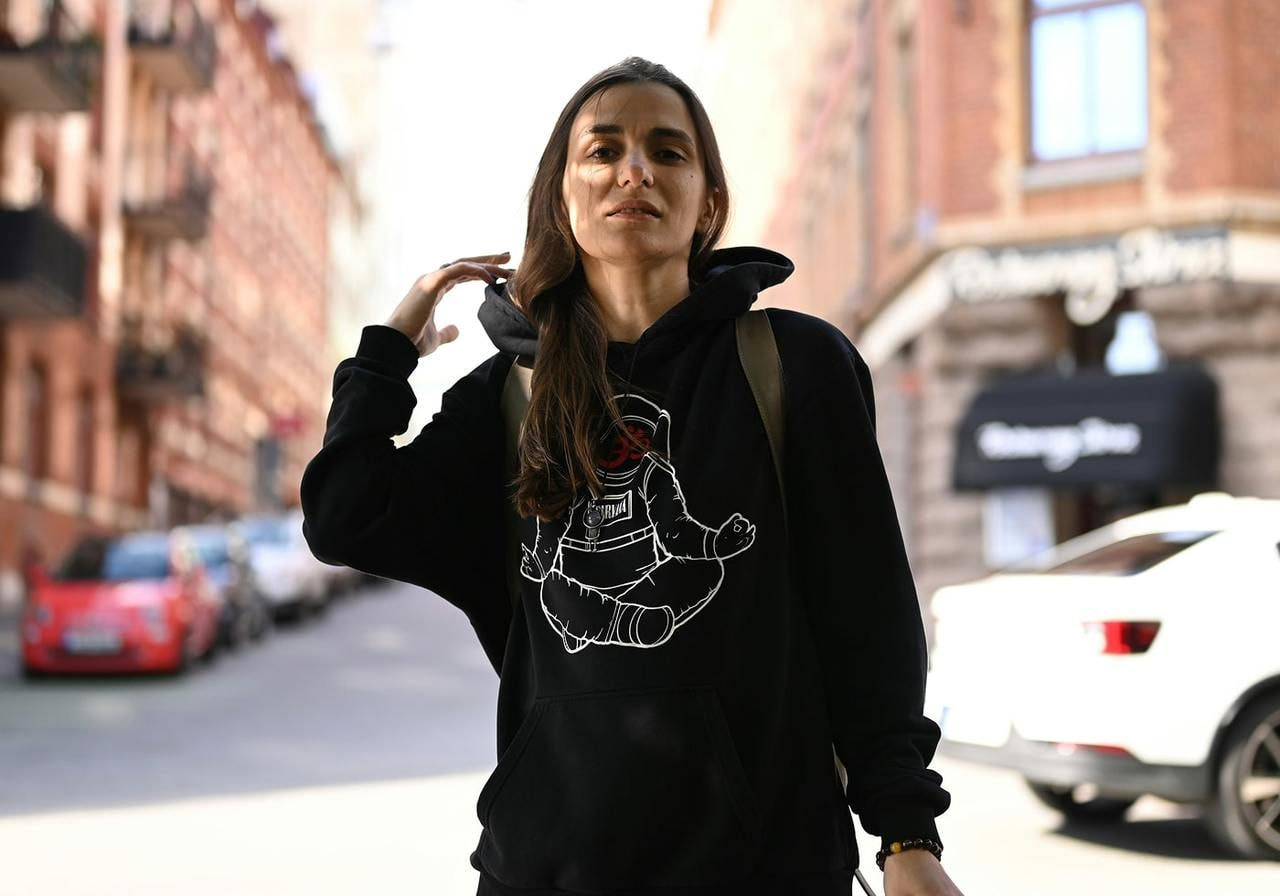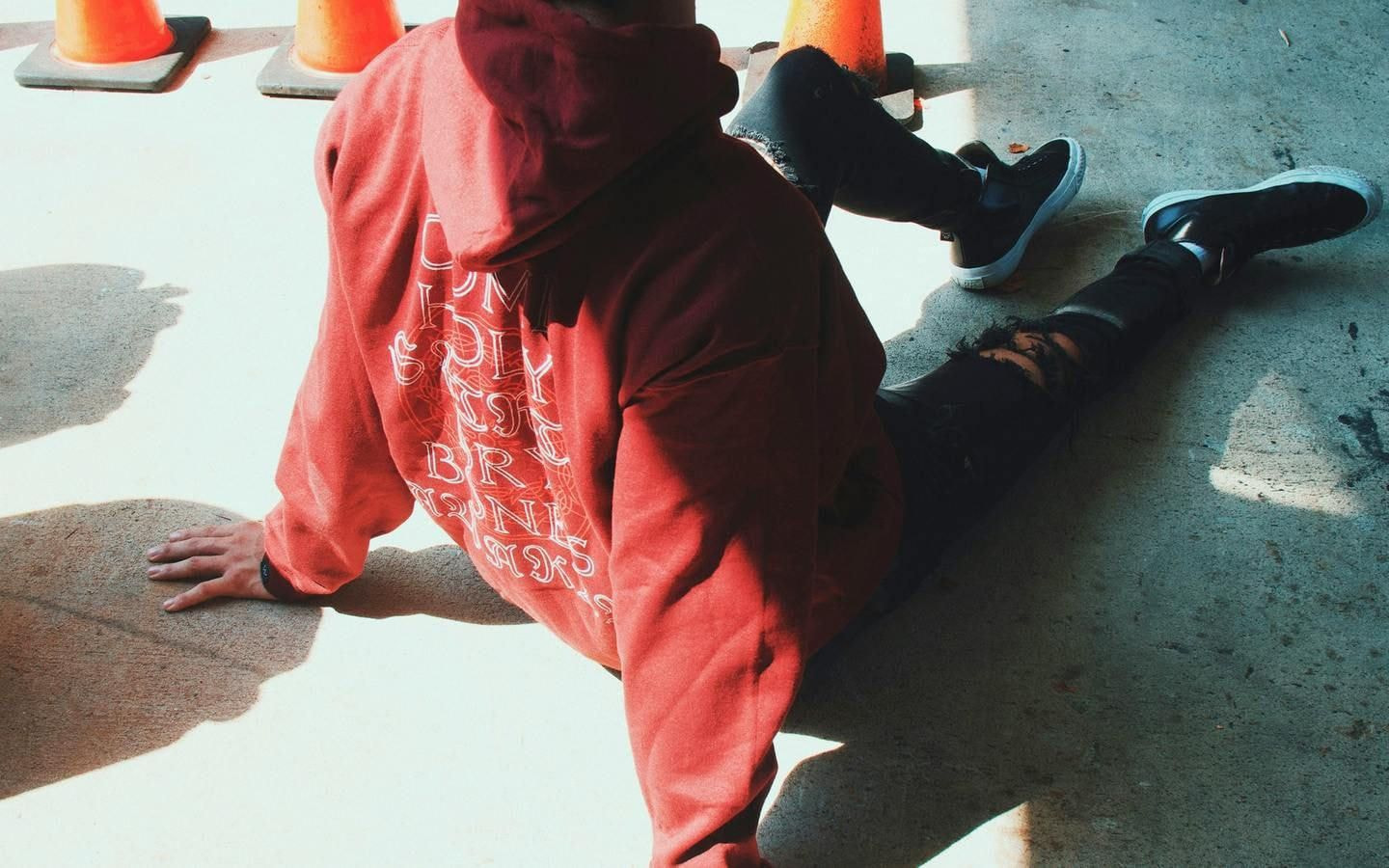Table of contents
New hoodie brands launch every day – but most disappear. Why? They blend in. A successful hoodie business knows its audience, picks the right products, and launches with a plan.
This guide shows you how to start a hoodie business in a crowded market – step by step. You’ll learn how to define your niche, build a strong brand, and launch an online store that sells. Let’s begin!
How to sell hoodies online in 10 steps
Let’s break down the process of how to start a hoodie business online into 10 easy steps – from finding your niche to closing your first sale.
1. Define your niche and target audience

The first step: decide who your hoodie business is for. Don’t chase broad trends like “streetwear” or “fitness” – find a market slice you can own. Think oversized hoodies for gamers, cropped hoodies for dance crews, or organic cotton hoodies for eco buyers.
Define your target audience by studying where they shop and talk. Check hashtags on social media platforms, read Etsy or Amazon reviews, and scan bestseller lists. Note what people praise (“thick fabric,” “custom embroidery”) and what they complain about (“shrinks after wash,” “limited sizes”).
Use these insights to shape your hoodie line. When your products answer real buyer needs, your custom hoodie business builds trust and earns credibility from day one.
2. Build a brand identity
Brand identity is your business’s look and personality. It’s the style, tone, and overall feel people pick up, even without thinking about it. A strong brand identity makes someone see your hoodie store and instantly know if it’s for them.
When running a custom hoodie business using Print on Demand (POD), it’s tempting to skip branding, but that’s a mistake. Stores without a clear brand identity often feel generic, making it harder to attract a loyal customer base or build a profitable hoodie business.
So, how do you build a brand identity? Start by defining your mission, vision, and values. They guide what your hoodie brand stands for and shape how it communicates.
Next, create your visual identity – logo, colors, fonts, and tone. These elements carry your identity into your online store, product mockups, and packaging.
Learn more: Explore our free course How to build a brand to create your brand identity step by step.
3. Choose the hoodies you’ll sell

The blank hoodies you pick will shape your clothing line. Each hoodie style attracts a different buyer type – whether that’s streetwear fans, eco-conscious shoppers, or Gen Z trendsetters. Let’s review common types of hoodies, so you can choose the right fit for your hoodie business.
The classic pullover hoodie is the most versatile wardrobe staple that works across genders and age groups. It’s a dependable choice for any clothing line – most hoodie businesses include at least one unisex pullover as it’s a proven style customers expect to find.
Zip-up hoodies are popular in sportswear and campus culture, thanks to their comfort and convenience. They’re also common in team and college athletics.
Today, zip-ups appeal to commuters, students, and anyone moving between indoors and outdoors. They carry a casual, sporty look and work well for athleisure or university pride clothing lines.
Cropped hoodies are trending with Gen Zs and TikTok-first shoppers, thanks to their ’90s-2000s nostalgic, fashion-forward appeal.
They belong in your line if your audience values fashionable, new hoodie styles alongside classic cuts.
Oversized hoodies are a streetwear staple. They attract buyers who want a relaxed, statement-making custom apparel, such as gamers, skaters, or urban fashion lovers. This style works well for brands pushing into premium or niche positioning.
These are designed for bold, full-coverage graphics. They’re a natural fit for niche communities like anime fans, street artists, or anyone who wants their hoodie to double as a canvas.
Made from organic or recycled fabrics, eco hoodies appeal to buyers who prioritize sustainability. They let you build an online hoodie business around conscious consumption values and higher-quality materials.
Pigment-dyed, tie-dye, or heavyweight styles give your brand a unique edge. They’re perfect for smaller drops, premium collections, or niche experiments that make your line feel exclusive.


4. Create hoodie design

Once you’ve chosen your hoodie styles, it’s time for the most exciting part – creating designs!
Start by researching what works in your niche. Use Pinterest or Instagram to spot trending looks. Then, save examples to a mood board to guide your style. Check our hoodie design ideas guide for inspiration.
When you create hoodies for your online business, keep seasonality in mind. Your core hoodie line should sell year-round, but you can drive urgency with holiday drops, limited editions, and event-based designs.
Once you have a direction, choose the right tools for the job. Free design tools like Canva are great for beginners, while advanced users favor Photoshop or Illustrator.
If you’re using Printful, our free Design Maker is the fastest way to make designs from scratch and instantly preview them on real products.
Valuable read: Free Photoshop alternatives to discover this year
5. Decide how to fulfill orders
When you start selling hoodies online, you need to decide how orders will be fulfilled – how your products get printed, packed, and delivered to customers.
Self-fulfillment
With self-fulfillment, you buy blank hoodies in bulk, print them in-house, and ship every order yourself. The upside is full control over production, and the price per unit will likely be lower than Print on Demand. The trade-off is hands-on inventory management and potentially losing money if your hoodies don’t sell.
Work with a manufacturer
You can also partner with a local manufacturer or print shop. This gives you access to professional printing methods like screen printing, embroidery, or DTG, without running production yourself.
Manufacturers often require minimum orders and long-term contracts, so this path works only once your hoodie brand has steady demand. You’ll still need to handle packaging and shipping, which leaves less time to focus on your brand and experiment with new designs.
Print on Demand (POD)
POD removes the biggest barriers to starting a hoodie business: upfront production costs, inventory management, and manual fulfillment.
You only pay for production when a customer orders, so there’s minimal financial risk. For most small business owners, it’s the smarter way to start. It keeps risks low while giving you the freedom to focus on building your brand.
Launch your own hoodie business with Printful today and access premium blank hoodies, professional printing, and global fulfillment.
6. Choose your customization method

Direct-to-garment (DTG) printing
DTG printing excels at photorealistic or intricate graphics without altering how the custom hoodies drape or feel. It’s ideal for streetwear drops, photo-style art, or complex illustrations. Great for custom hoodie brands aiming for sharp visuals with minimal weight or texture change.
Direct-to-film (DTF) printing
DTF prints are highly durable, vibrant, and they resist cracking or peeling, even on thicker fabrics and blends. It’s because DTF prints sit on top of the fabric, creating a surface layer you can feel.
However, the design area won’t be as soft or draped as the rest of the hoodie. Still, it’s a strong choice if you want prints that last through heavy wear.
Sublimation
Sublimation lets you cover the entire custom hoodie with your design, including sleeves and the hood. Sublimation uses heat to fuse your design into the fabric, so the print becomes part of the hoodie, not just a layer on top.
Sublimation is ideal for hoodies with full-coverage designs, like team uniforms, gradient effects, or graphic-heavy streetwear.
Embroidery
Embroidery gives hoodies a textured, premium finish that feels luxurious. It’s especially popular for logo or text designs and minimalist looks where the detail and raised stitching signal quality.
Embroidered hoodies are trending in streetwear and boutique fashion thanks to their durability, high-end look, and timeless appeal.
7. Choose where to sell your hoodies
Once your custom hoodies are ready, it’s time to choose where to sell them. Launch your own site through eCommerce platforms like Shopify or list your products on online marketplaces like Etsy or Amazon. Many successful hoodie brands do both to maximize reach.
Whichever you choose, present your custom hoodies with high-quality photos, compelling product descriptions, and competitive pricing. Strong branding and consistent quality will create a trustworthy online shopping experience for your customers.
Not sure which eCommerce platform is right for you? See Printful’s integrations and take a quick quiz to find your match.
8. Price your hoodies for profit
Pricing is one of the most critical steps in building your new hoodie business. In a print-on-demand business model, your profit is the difference between the product cost and the price you set on your online store. Customers pay the retail price, your POD partner keeps the fulfillment cost, and the rest is your profit.
Your pricing strategy reflects your target market. Are your customers looking for exclusive, fashion-forward hoodies – or affordable basics?
Premium products like custom embroidered hoodies can be priced higher because buyers associate them with high quality. Same with unique or limited-run designs – they offer something customers can’t find elsewhere.
Look at what similar brands are charging in retail stores and online. Use that as a benchmark, then adjust based on your production costs, brand positioning, and business strategy.
Valuable read: How to price your print-on-demand products
9. Develop your marketing strategy

Your marketing plan should focus on the channels that fit your brand and audience. Not every method works for every hoodie business – choose tactics that play to your strengths and reach the buyers you want.
Email marketing is one of the best tools for keeping customers engaged. Use it for product launches, seasonal drops, and discounts that bring people back to your online store.
Social media marketing helps you build a community and show your hoodie designs in real-world settings. Platforms like Instagram and TikTok are powerful for fashion and lifestyle brands that thrive on visual storytelling.
Influencer marketing lets you reach new buyers through trusted creators in your niche. A well-timed hoodie post in front of the right following can generate immediate traffic and sales.
Content marketing works long-term by telling your brand story, building authority, and answering customer questions. Blog posts, style guides, or behind-the-scenes videos build trust and help your site appear in search engines.
Search engine optimization (SEO) helps your hoodie brand appear in search results when your target audience looks for products like yours. Include relevant keywords in your product titles, descriptions, and blog content so customers find you instead of competitors.
Marketing doesn’t stop at checkout. Your packaging and unboxing experience reinforce your brand just as much as your storefront. Use POD features like branded labels, inserts, and packaging to make your customized hoodies feel like they came from your brand, not a supplier’s warehouse.
Valuable read: Printful branding tools to create a consistent look and feel for your brand
10. Fulfill orders with Printful

Once sales start coming in, reliable fulfillment keeps your online business running smoothly. With Printful, you don’t need a warehouse or shipping setup – every order is printed, packed, and shipped directly to your customer.
Create hoodies with Printful’s free design tools, apply your hoodie designs to various hoodie styles, and preview how your designs will look with realistic mockups. Once your design’s ready, publish it to your store in a few clicks – the entire process takes just a few minutes.
With Printful’s automated fulfillment, you have more time to focus on what matters most: marketing, customer service, and building your brand. It’s a scalable system that lets you start lean and expand as orders increase – without the usual overhead.
Start building your hoodie business today
Now you know how to start a hoodie business online. Turning that knowledge into a successful hoodie business takes planning: defining your niche, creating designs that resonate, and choosing the right fulfillment model.
Printful simplifies the process with automated fulfillment, powerful design tools, and premium quality, letting you focus on your hoodie brand full-time. Design your hoodies in minutes, add them to your store, and get them in front of customers today!


FAQ: How to start a hoodie business
Yes. Hoodies are one of the most popular items in the fashion industry because they’re versatile, unisex, and sell year-round. Profit depends on your pricing, production costs, and marketing, but many brands build strong margins by positioning hoodies as premium lifestyle products.
To launch your own hoodie business online, begin with a clear business idea and niche. Define who your hoodies are for, then use market research tools like Google Trends or social media insights to validate demand.
From there, build a clothing business plan that covers branding, production, pricing, and sales channels. Then, follow that plan to start your online store and launch the first products.
Retail prices typically range from $25 to $70, depending on fabric weight, quality, and branding. A luxury clothing company may charge more, while budget retailers compete on price. Always consider your target audience – what matters most is consistent quality and customer satisfaction, not just the lowest price.
Not if you’re offering value. For example, premium fabrics, embroidery, or limited drops make custom hoodies worth $50 or more in the eyes of buyers. Positioning is key: if your brand tells a compelling story and delivers quality, $50 is a fair and competitive price.
Printful’s free Design Maker gives you thousands of assets to experiment with. Browse clipart or Quick Designs to spark new hoodie design ideas, upload your own graphics, or add text. The tool also lets you preview realistic mockups to see exactly how your design will look before launching it.

Printful is an on-demand printing and fulfillment service that helps businesses create and ship custom products.





